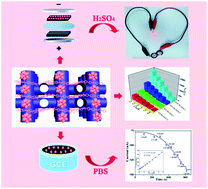A 3D POMOF based on a {AsW12} cluster and a Ag-MOF with interpenetrating channels for large-capacity aqueous asymmetric supercapacitors and highly selective biosensors for the detection of hydrogen peroxide†
Abstract
{AsW12O40} clusters were grafted onto Ag-MOF to yield two 3D polyoxometallate-based metal organic frameworks (POMOFs), (imi)2[{Ag3(tpb)2}2(H2O){AsW12O40}2]·6H2O (1) and [(Ag7bpy7Cl2){AsWV2WVI10O40}]·H2O (2) (imi = imidazole; tpb = 1,2,4,5-tetrakis(4-pyridyl)benzene; bpy = 4,4′-bipyridyl). These compounds are complicated 3D networks with intersecting channels and novel topologies. They exhibit larger capacitances (929.7 and 986.1 F g−1 at a current density of 3 A g−1), superior rate capabilities, higher capacity retention rates, boosting conductivities and electrocatalytic activities compared to those of their maternal POM, and this can be ascribed to the introduction of Ag-MOF, interpenetrating channels, and the unique stability of the POMOF. An aqueous asymmetric supercapacitor equipment, assembled with 2-CPE, displays remarkable energy density (16.1 W h kg−1) with a power density of 1748.9 W kg−1 and durable cyclic stability. The practical application capability as a power supply device can be confirmed by lighting a red light-emitting diode. Moreover, 2-GCE as a H2O2 biosensor reveals a lower detecting limit (0.48 μM), a wider linear range (1.43 μM to 1.89 mM), high selectivity and high reproducibility, and this was further demonstrated by detecting H2O2 in real blood serum samples.



 Please wait while we load your content...
Please wait while we load your content...